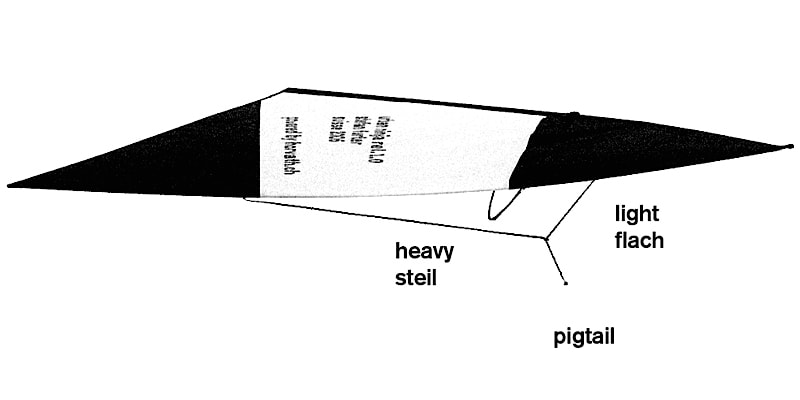Bridle setups
How different bridle setups modulate the flight characteristics of a single line zero wind kite. In general: adjust the bridle "light" at lively flights in no wind, or "heavy" at high static flights in some wind.
Is your bridle setup too light or too heavy?
Light adjusted bridle
Enables the immediate initiation of a flat-spin almost at any moment thanks to a more lively behavior in flight, e.g. while in the climbing phase of a high start. Also, the kite will pull a bit less. Generally, a light bridle (or "flat" in german: The attitude of the kite is rather flat, towards horizontal) supports the active agile flying style. You have reached the limit towards the front when the rear segment of the bridle is scratching the spreader.
Heavy adjusted bridle
The urban ninja or whatever is traveling straight as a carbon rod to the zenith with explicit pull. You feel the efficiency in your fingers. Flying e.g. the long way home though, flat-spins or other moves will be harder to initiate due to the stable, aligned position of the kite in the sky ("steep" in german: the attitude of the kite is rather steep, towards vertical). The limit towards rear: Such heavy, that the kite will hardly lift off, but pull like crazy.

Bridle concepts on dual line kites
We tested active bridle configurations too, but as often, everything has its price. Even though some kind of active bridle can combine a bit of both light and heavy characteristics, the sharp firm input to the kite is tamed.
The "active bridle" for dual line freestyle kites was established by Andy Wardley and first implemented in the Benson Outerspace. There are also dynamic or turbo bridles. European champ Stefan Furter and others prefer to develop and fly static - three point - bridles on their stunt kites.They rely on the direct contact to their sophisticated competition kites for a perfect control in precision and tricks.
There are also bridles on Revolutions, but not only. With 4 flying lines you can also interact directly with the kite without any bridle. But this is beyond my competence.
The bridle on a zero wind kite
Our kites have the minimum possible 2-point bridle. Between it and the flying line the pigtail is connected, each with a simple larkshead loop.
Being active designs, our kites should respond directly to inputs, so fly them with a rather light adjusted bridle. In practice: Fly with a light bridle in the courtyard, adjust it a few millimeters heavier for high broad space soaring in Sils Maria. Test extreme setups.
Factory setup: The bridles on Horvath-Kites are set up rather light to achieve versatile, agile flight characteristics.
Also, the lenght of the flying line has some influence on the agility of your kite. With a short line the kite converts your crisp inputs directly, a long line dampens the inputs.
More on bridles: The urban ninja kite making project: Bridle adjustments.